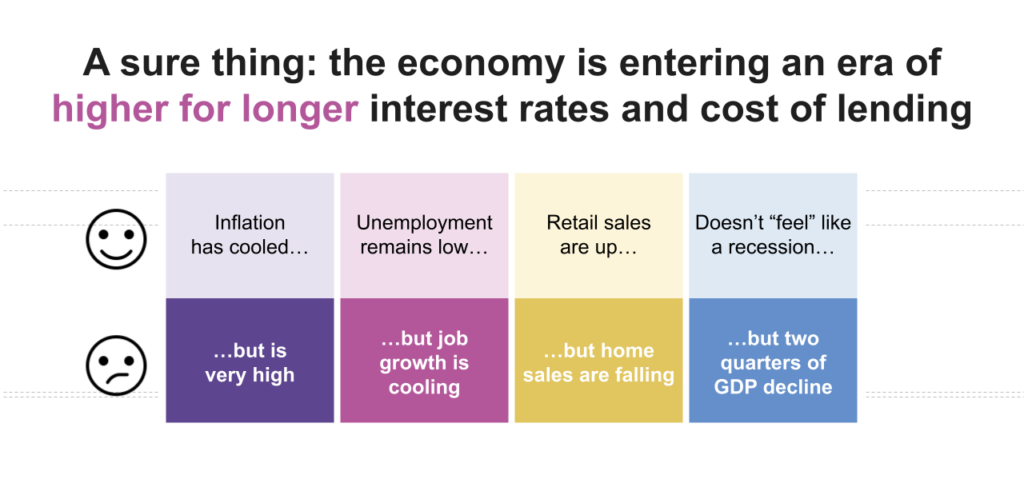How Boosting Your Acquisition & Retention Efforts Now Will Prepare Your Organization for Uncertain Economic Times

Many organizations may feel compelled to cut costs when the near-term economic outlook worsens. A proactive tightening of the belt may seem like good business sense. Your organization is likely exploring such cost-saving measures going into 2023. However, you must be strategic with your cuts and consider both the short- and long-term impacts. Otherwise, you could be faced with even more losses.
The Department of Commerce found the gross domestic product (GDP) grew by 2.6% in Q3 of 2022. However, higher interest rates and other key economic indicators, such as a slowdown in the housing market, point to a downturn. Just as you scrutinize your budget, consumers also make hard decisions about how they spend their money. So, you’ll want to ensure your cause remains among their priorities.

Deciding where to invest your precious resources during volatile times can be especially difficult. Due to its great expense, many organizations may choose to dial back on acquisition and instead shore up other aspects of their fundraising.
But is cutting donor acquisition ever a good move? Not if you want to emerge from the economic slump well-positioned. This is not the time to disappear from your donors’ lives and inboxes, nor is it the time to stop stewarding new donors. Retention and acquisition can keep your organization poised for growth, even when times get tough.
How Does Acquisition Fit Into Your Bigger Picture?
Before you can manage donor acquisition efforts ahead of challenging economic times, you must first consider the stages of your donor pipeline year over year. Is the number of new donors increasing or decreasing? What about the number of donors who discontinue giving? Is that number more or less than newly acquired donors?
The net change in your active donor file is your donor coverage ratio, a critically important metric that evaluates both your acquisition and retention efforts.
On the acquisition side, your donor coverage ratio can help determine whether you’re taking on enough new donors to replace lapsed ones. A healthy donor coverage ratio is at least 100%, meaning the number of new donors divided by the total number of lapsed donors is 100% or greater.

Looking at donor acquisition through the lens of your donor pipeline, it becomes clear that donor acquisition is indispensable. Donors hit by hard times will cut unnecessary spending, which could include gifts to your organization. You must ensure new donors are there to take their place through effective donor acquisition strategies. Otherwise, you risk worsening the impact of an economic recession on your organization.
So, What About Retention?
Data shows that when economic times are tough, we, as nonprofit marketers and fundraisers, must build strategies around keeping the donors and constituents we have while continuing to acquire new ones. Finding cost-effective and data-driven ways to maintain a robust pipeline of loyal donors can make or break an organization amid an economic downturn.
Acquisition and retention efforts go hand-in-hand. One cannot exist without the other if you want to maintain a solid donor pipeline. Consider the Fundraising Effectiveness Project’s (FEP) 2022 Quarterly Report, which tracks nonprofit fundraising data and trends. It suggests a considerable spike in first-time and one-time “crisis” donors between 2020 and 2021 accounts for a surge in new donors, many of which lapsed as organizations failed to follow up with solid retention efforts to build relationships.
Giving data for the first six months of 2022 can provide clues about what to expect as we enter the last quarter of the year. For instance, giving in early 2022 was up 6.2% and driven by large donors, but the overall number of donors fell 7%. In addition, the donor retention rate fell 4.2% from 2021 to 2022.
Keeping the donors you already have will become even more important if a receding economy makes acquiring new donors more difficult. The time to invest more in BOTH acquisition and retention strategies is now.
Get Proactive With Retention and Acquisition
The prospect of intensifying donor acquisition and retention efforts on the cusp of economic hard times might initially sound intimidating, but this is where it pays to work smarter, not harder. Many nonprofit organizations are enlisting the help of donor analytics and wealth screening platforms such as GivingDNA, allowing small organizations to better focus their limited resources on reaching their best prospects with the right message, on the right channel, at the right time.
For example, this type of software can help organizations prioritize and focus direct mail assets, which have become much more expensive amid a paper supply shortage and increased postage. Couple that with the continued trend of declining direct mail response rates, and you have a heightened need to be smart with your direct mail investments.
Precision segmentation options within the tool’s dashboard allow fundraisers to send more personalized messages to those who are more digitally responsive. Over time, data curated by the tool will inform what messages resonate with each active donor and prospect. Such an upfront investment in state-of-the-art fundraising tools and collaborative expert training has been shown in case studies to quickly pay dividends, making modernization an essential and sound strategy.
Ensure Your Retention Metrics Are Accurate
Accurate metrics are critical if you aim to improve donor retention. Focusing exclusively on dollars raised, the number of donors, and the percentage of donors retained year to year—the three most common measures organizations evaluate consistently—can mask significant problems within a fundraising strategy and hide success stories.
Measuring retention can also be deceiving. One organization, for example, grew 16-fold from 420 annual donors to 6,800 donors in three years. Just by looking at these numbers, it appears retention decreased from 46% to 18% during this explosive growth period. By digging a little deeper, however, the organization’s retention of donors had actually improved — it was retaining 10 times more donors than it had before. Donor retention as a percentage of the available donors was smaller, but it represented significantly more donors each year. Its inverse — the equation’s denominator—had grown more dramatically. So, while retention wasn’t keeping pace with the growth, it wasn’t a failure either.
Without further inquiry, this organization might have stopped its acquisition efforts to focus on shoring up retention instead. Or it might have thrown out its stewardship program and started over. Both moves would have been serious mistakes. But by harnessing the power of a data-driven strategy fueled partly by their recent investment in the donor intelligence platform GivingDNA (calculate your organization’s potential ROI here), they remained on a steep growth trajectory — even through the height of the pandemic. GivingDNA unearthed data that allowed them to develop a strategy to target constituents with higher giving capacity and a greater likelihood of being ready to make a sustaining commitment.
The fundraising experts at GivingDNA are ready to help you elevate your organization’s data, analytics, and strategies. Want to see your donor file’s real-time retention rates easily? Contact us today to get started with a free demo.